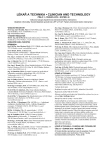-
Články
- Časopisy
- Kurzy
- Témy
- Kongresy
- Videa
- Podcasty
CROSSOVER FROM AUTOMATED TO MANUAL TITRATION OF FiO2 IN THE NICU: IS THERE A TRANSITION LAG?
Effective management of oxygenation of preterm infants in critical care profoundly impacts their outcome. Nurses are challenged to titrate the inspired oxygen in response to constant cardiopulmonary instability. Closed loop control of inspired oxygen based on continuous monitoring of oxygen saturation is just becoming available. Evaluating the relative effectiveness of closed loop control systems is complicated by the wide variability in manual control by nurses. This analysis explored the possibility of a lag in effective control associated with the transition from closed loop to manual control using data from a clinical crossover trial. A short but marked lag phase was detected. It is, however, unlikely to have impact on clinical care or crossover studies. Its presence highlights the anticipative nature of closed loop control as contrasted to the observative nature of manual control.
Keywords:
Neonatal critical care, oxygen control, closed loop oxygen control
Autoři: Thomas Bachman; Karel Roubík
Působiště autorů: Czech Technical University in Prague, Czech Republic
Vyšlo v časopise: Lékař a technika - Clinician and Technology No. 2, 2016, 46, 37-40
Kategorie: Původní práce
Souhrn
Effective management of oxygenation of preterm infants in critical care profoundly impacts their outcome. Nurses are challenged to titrate the inspired oxygen in response to constant cardiopulmonary instability. Closed loop control of inspired oxygen based on continuous monitoring of oxygen saturation is just becoming available. Evaluating the relative effectiveness of closed loop control systems is complicated by the wide variability in manual control by nurses. This analysis explored the possibility of a lag in effective control associated with the transition from closed loop to manual control using data from a clinical crossover trial. A short but marked lag phase was detected. It is, however, unlikely to have impact on clinical care or crossover studies. Its presence highlights the anticipative nature of closed loop control as contrasted to the observative nature of manual control.
Keywords:
Neonatal critical care, oxygen control, closed loop oxygen control
Zdroje
[1] Claure N., Bancalari E. Closed-loop control of inspired oxygen in premature infants. Semin Fetal Neonatal Med. 2015; 20(3), p. 545-50.
[2] Wilinska M., Skrzypek M., Bachman T., et al. Using the automated FiO2-SpO2 control in neonatal intensive care units in Poland: a preliminary report. Developmental Period Medicine, 2015; XIX, 3(I), p. 263-70.
[3] Fathabadi O.S., Gale T.J., Olivier J.C., Dargaville P.A. Automated control of inspired oxygen for preterm infants: What we have and what we need. Biomedical Signal Processing and Control. 2016; 28, p. 9–18.
[4] Sola A., Golombek S., Bueno M.T., et al. Safe oxygen saturation targeting and monitoring in preterm infants: can we avoid hypoxia and hyperoxia? Acta Paediatr. 2014; 103(10), p. 1009-18.
[5] Sivan Y., Deakers T.W., Newth C.J. An automated bedside method for measuring functional residual capacity by N2 washout in mechanically ventilated children. Pediatr Res. 1990; 28(5), p. 446-50.
[6] Fathabadi O.S., Gale T.J., Lim K., et al. Characterisation of the oxygenation response to inspired oxygen adjustments in Preterm Infants. Neonatology 2016; 109, p. 37–43.
[7] Wilinska M., Bachman T., Swietlinski J., Wasko A. Quicker response results in better SpO2 control – a comparison of 3 FiO2-titration strategies in ventilated preterm infants. AAEM 2015, 22, (4), p. 736–40.
[8] van Kaam A.H., Hummler H., Wilinska M., et al. Automated versus Manual Oxygen Control with Different Saturation Targets and Modes of Respiratory Support in Preterm Infants. J Pediartr 2015; 167(3), p. 545-50.
[9] Poets C.F., Roberts R.S., Schmidt B. et al. Association between intermittent hypoxemia or bradycardia and late death or disability in extremely preterm infants. JAMA. 2015; 314(6), p. 595-603.
[10] Kaufman D.A., Zanelli S.A., Gurka M.J., et al. Time outside targeted oxygen saturation range and retinopathy of prematurity. Early Human Development. 2014; 90(2), p. 35–40.
[11] Sink D.W., Hope S.A., Hagadorn J.I. Nurse: patient ratio and achievement of oxygen saturation goals in premature infants. Arch Dis Child Fetal Neonatal Ed 2011; 96(2), p. 93–8.
Štítky
Biomedicína
Článok vyšiel v časopiseLékař a technika

2016 Číslo 2-
Všetky články tohto čísla
- CROSSOVER FROM AUTOMATED TO MANUAL TITRATION OF FiO2 IN THE NICU: IS THERE A TRANSITION LAG?
- DESIGN CONCEPTS FOR PREVENTING GAS BUBBLE INTERFERENCE IN MICROFLUIDIC DEVICES
- CELL-BASED SENSOR CHIP FOR NEUROTOXICITY MEASUREMENTS IN DRINKING WATER
- TESTING A SYSTEM FOR PREDICTING MICROSLEEP
- EARLY DISCHARGE (48–72 HOURS) AFTER ACUTE ST-SEGMENT ELEVATION MYOCARDIAL INFARCTION: INTERIM RESULTS OF THE OPEN, RANDOMIZED, MONOCENTRIC STUDY
- Lékař a technika
- Archív čísel
- Aktuálne číslo
- Informácie o časopise
Najčítanejšie v tomto čísle- EARLY DISCHARGE (48–72 HOURS) AFTER ACUTE ST-SEGMENT ELEVATION MYOCARDIAL INFARCTION: INTERIM RESULTS OF THE OPEN, RANDOMIZED, MONOCENTRIC STUDY
- CELL-BASED SENSOR CHIP FOR NEUROTOXICITY MEASUREMENTS IN DRINKING WATER
- TESTING A SYSTEM FOR PREDICTING MICROSLEEP
- DESIGN CONCEPTS FOR PREVENTING GAS BUBBLE INTERFERENCE IN MICROFLUIDIC DEVICES
Prihlásenie#ADS_BOTTOM_SCRIPTS#Zabudnuté hesloZadajte e-mailovú adresu, s ktorou ste vytvárali účet. Budú Vám na ňu zasielané informácie k nastaveniu nového hesla.
- Časopisy


